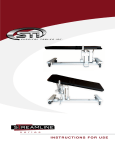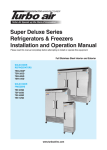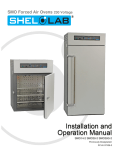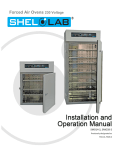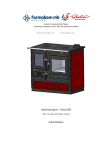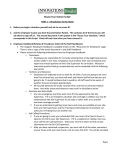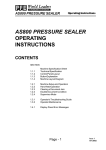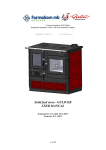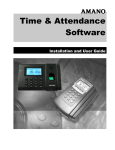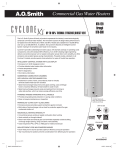Download AS900 PRESSURE SEALER OPERATING INSTRUCTIONS
Transcript
AS900 PRESSURE SEALER
Operating Instructions
AS900 PRESSURE SEALER
OPERATING
INSTRUCTIONS
CONTENTS
SECTION
Machine Specification Sheet
1.1
Technical Specification
1.2
Control Panel Layout
1.3
Button Explanation
1.4
Machine Layout Diagram
2.1
Machine Setup and Operation
2.2
Hand-feed Operation
2.3
Clearing a Document Jam
2.4
Double Document Condition
2.5
Supervisor Mode
3.1
Operator's Troubleshooting Guide
3.2
Operator Maintenance
4.1
Display Panel Error Messages
Page - 1
ISSUE 1
APR 2003
Operating Instructions
AS900 PRESSURE SEALER
MACHINE SPECIFICATION SHEET
1.
CAUTION:
In order to ensure correct safety and operation, this machine must be
installed and maintained by an authorised Service Engineer.
2.
CAUTION:
Should any cover or safety interlock be damaged, the machine must not
be used until service repairs have been completed.
3.
CAUTION:
This machine must be grounded. Wire colors in the power cord are:
110-120V
Green
White
Black
220-240V
Green/Yellow
Blue
Brown
Connect to:
Ground (Earth)
Neutral
Live (Line)
4.
CAUTION:
This machine must not be used if the power cord is damaged. It must be
replaced with a similar power cord:
UK
Part no. 162-210
EURO
Part no. 162-311
US
Part no. 162-321
5.
CAUTION:
For continued protection against risk of fire, replace with the same type
and rating of fuse. The fuse rating and type for this machine is:
110-120V
220-240V
6.
T6.3A 250V
T3.15A 250V
Part no. 135-106
Part no. 135-103
Model Details:
Model name:
Pressure Sealer
Model number: AS900
Input voltage: 110-120V @ 60Hz
220-240V @ 50Hz
Input current: 6 Amps
3 Amps
Input power:
720 Watts
720 Watts
Sound output: 80dBa
80dBa
(measured at 1 meter from the cover and 1.6 meters from the ground)
Weight:
390lbs (176kg) - unpackaged
460lbs (210kg) - packaged with accessories
Lifting or handling must only be carried out by competent persons using appropriate means.
7.
The use for the machine is pressure sealing documents.
Distributor and Service contact:
ISSUE 1
APR 2003
Page- 1a
Page
22
Operating Instructions
AS900 PRESSURE SEALER
DONNEES TECHNIQUES DE LA MACHINE
1.
ATTENTION:
Afin de garantir un fonctionnement en toute sécurité, cette machine
doit être installée et entretenue par un technicien agréé.
2.
ATTENTION:
Si le couvercle ou le mécanisme de blocage de sécurité est
endommagé, ne pas utiliser la machine tant que les réparations n’ont
pas été effectuées.
3.
ATTENTION:
4.
ATTENTION:
5.
ATTENTION:
6.
Spécifications:
Cette machine doit être raccordée à la terre. Les fils de couleur du
câble d’alimentation sont:
110-120V
220-240V
Connecté:
Vert
Vert/Jaune
à la terre (masse).
Blanc
Bleu
au neutre.
Noir
Brun
à la tension.
Cette machine ne doit pas être utilisée si le câble d’alimentation est
endommagé. Il y a lieu de le remplacer par un câble similaire:
UK
N° de pièce 162-210
EURO
N° de pièce 162-311
US
N° de pièce 162-321
Pour ne pas compromettre la protection contre les risques d’incendie,
remplacer par un fusible de même type at de mêmes caractéristiques
nominales:
110-120V
T6.3A 250V
N° de pièce 135-106
220-240V
T3.15A 250V N° de pièce 135-103
Nom du modèle:
Pressure Sealer
Numéro du modèle:
AS900
Tension d’entrée:
110-120V à 60Hz
220-240V à 50 Hz
Courant d’entrée:
6A
3A
Puissance d’entrée:
720W
720W
Niveau de bruit:
80 dBA
80 dBA
(mesuré en insérant un seule feuille dans une enveloppe à une distance
de 1 mètre du capot le plus proche et à 1,6 mètre du sol).
Poids:
176kg (390lbs) déballée
210kg (460lbs) avec accessoires
Le levage ou la manipulation de la machine ne peut être effectué que par des personnes
qualifiées utilisant l’outillage approprié.
7.
Cette machine est conçue tout spécialement pour fermer avec la pression les documents.
Page- 23
1b
Page
ISSUE 1
APR 2003
AS900 PRESSURE SEALER
Operating Instructions
1.1 TECHNICAL SPECIFICATION
Machine type:
Medium volume pressure sealer
Speed:
Variable, up to 8500 documents per hour
(based on 8½" x 11" 'Z'-folded documents)
Volume to a maximum of:
15,000 documents per day
70,000 documents per week
250,000 documents per month
3 million documents per year
Document dimensions (folded flat):
Electrical Specification:
Current
Fuse
Sound Level:
ISSUE 1
APR 2003
230v
3A
T3.15A
115v
6A
T6.3A
80 dBA, measured at 1 metre from nearest cover and
1.6m from the ground.
Page - 2
Operating Instructions
AS900 PRESSURE SEALER
1.2 CONTROL PANEL LAYOUT
12
1
2
1.
2.
3.
4.
5.
6.
7.
8.
9.
10.
11.
12.
10
3
5
11
4
6
12
7
8
9
Stop button
Start button
Speed decrease button
Speed increase button
Speed indicator
Setup button
Hand feed button
Jog reverse button
Jog forward button
Zero reset (in-count) button
Zero reset (out-count) button
Display panels
A detailed description of each button function is given
in the following section.
Page - 3
ISSUE 1
APR 2003
AS900 PRESSURE SEALER
Operating Instructions
1.3 BUTTON EXPLANATION
1.
Stop button: Allows documents currently passing through machine to
continue to output, then halts operating cycle.
2.
Start button: Starts machine into continuous running, and also cancels
any errors which may be indicated after the cause of the problem has
been cleared by the operator.
3.
Speed decrease button: Decreases speed in steps down to 0, shown on
speed indicator display.
4.
Speed increase button: Increases speed in steps up to 9, shown on
speed indicator display.
5.
Speed indicator: Indicates speed in steps from 0 to 9 (max.)
6.
Setup button: Feeds through a single document in order to calibrate
document length and weight. This is for double document detection.
Document is diverted before sealing to enable fold lengths to be
checked.
7.
Hand feed button: Allows single document to be fed through pressure
rollers. Note: document must be pre-folded by hand, and placed in
folder bypass chute.
8.
Jog reverse button: "Jogs" document back through machine in small
steps. Used for clearing jams. Note: after operating, there is a 2 second
pause before button can be operated again.
9.
Jog forward button: "Jogs" document forward through machine in
small steps. Used for clearing jams. Note: after operating, there is a 2
second pause before button can be operated again.
10.
Zero reset (in-count) button: Zeroes counter display for documents fed
in (machine must be stopped). Note: count will maintain until zero
reset is pressed, even when machine is stopped or switched off.
11.
Zero reset (out-count) button: Zeroes counter display for documents
fed out (machine must be stopped). Note: count will maintain until
zero reset is pressed, even when machine is stopped or switched off.
12.
Display panels: Displays in or out count, and also error messages.
ISSUE 1
APR 2003
Page - 4
AS900 PRESSURE SEALER
Operating Instructions
1.4 MACHINE LAYOUT DIAGRAM
The following diagram shows the main parts of the AS900 Pressure Sealer. Full details of any
adjustments or setting required for the parts are shown in Section 2.1 onwards.
Page - 5
ISSUE 1
APR 2003
AS900 PRESSURE SEALER
Operating Instructions
2.1 MACHINE SETUP AND OPERATION
1.
Plug in machine, switch on at power switch and release emergency stop button.
2.
Adjust the separator gap to suit the document form, as shown below.
Turn the separator adjustor until there
is sufficient gap between the grip
roller and the pick-up roller below it to
allow one form only to pass through.
This is achieved by moving the form
back and forth between the rollers
until resist- ance is just felt and the
rollers lightly grip the form.
Stack guide
Grip roller
Centrally place a form in the insert tray
and move both side guides to leave a
gap of 1/16" (1-2mm) either side of the
form. Note: guides will self center.
Stack bridges
Insert tray
3.
Establish fold type and length required, raise the folder cover and set the fold plates as
described below:
Lock screw
Fine adjustment knob
Fold plate 1
Squareness adjuster
Pointer (align
inside edge
with scale)
Stop
Fold plate 2
contd.
ISSUE 1
APR 2003
Page - 6
AS900 PRESSURE SEALER
Operating Instructions
The fold plate stops are adjusted by loosening the lock screws, sliding the stop to the required
position as indicated by the pointer against the scale, and retightening the lock screws. A fine
adjustment is provided by turning the knob shown. This will adjust the fold position by small
amounts if a running test shows this to be needed.
Additionally, the squareness of the stop can be adjusted by loosening the squareness adjuster
lock screw and turning the knurled cam knob below it. This may be required if running tests
reveal that the documents are being folded 'skewed'. Retighten the lock screw after any adjustment is made.
The scales accord with the exact measured position of the required fold on the document, and
the inside edge of the pointer is aligned with the scale measurement (see diagram on previous
page). For example, if the first fold is required at 4" (102mm) down from the leading edge of
the document, set fold plate 1 at this position. The crease then becomes the leading edge for
the second fold position, so if the second fold is required at 4½" (114mm) from the crease, set
fold plate 2 at this position. Note that if the squareness adjuster has been moved at any time,
the pointer position will change, and this will have to be compensated for when measuring
fold positions. Running tests will reveal to what extent.
The fold plates are removable and are retained by clips. If the document requires only a single
center fold, slide out fold plate 2. Turn it round the other way and also turn it over, then slide
it back into position. This then acts as a blanking plate and the document will bypass it. Set
the stop of fold plate 1 to half the length of the document.
The three types of fold which may be used are shown overleaf:
Page - 7
ISSUE 1
APR 2003
AS900 PRESSURE SEALER
Below are shown the three types of fold which may be used:
1.
Letter (or Wallet) Fold
2.
Accordian (or 'Z') Fold
3.
Single (or Half) Fold
ISSUE 1
APR 2003
Page - 8
Operating Instructions
MID.
PANEL
BOT.
PANEL
FORMS LOADED INTO HOPPER
FOLD
PLATE
1
FOLD
PLATE
2
FINAL
ADDRES
V
11"
5 1/2"
N/A
5 1/2"
Address Panel Down & Trailing
5 1/2"
Blocked
Down
V
11"
5 1/2"
N/A
5 1/2"
Address Panel Down & Leading
5 1/2"
Blocked
Up
Z
11"
3 2/3"
3 2/3"
3 2/3"
Address Panel Down & Trailing
7 1/3"
3 2/3"
Up
Z
11"
3 2/3"
3 2/3"
3 2/3"
Address Panel Up & Leading
7 1/3"
3 2/3"
Down
C
11"
3 11/16"
3 11/16"
3 5/8"
3 5/8"
3 11/16"
Up
Eccentric C - Ceridian
11"
3 3/4"
3 13/16"
3 7/16"
3 7/16"
3 13/16"
Down
Eccentric Z
11"
4 1/4"
4 1/4"
2 1/2"
Address Panel Down & Trailing
8 1/2"
4 1/4"
Up
Eccentric Z
11"
2 1/2"
4 1/4"
4 1/4"
Address Panel Up & Leading
6 3/4"
4 1/4"
Down
Z
14"
4 2/3"
4 2/3"
4 2/3"
Address Panel Down & Trailing
9 1/3"
4 2/3"
Up
Z
14"
4 2/3"
4 2/3"
4 2/3"
Address Panel Up & Leading
9 1/3"
4 2/3"
Down
Eccentric Z
14"
5 1/4"
5 1/4"
3 1/2"
Address Panel Down & Trailing
10 1/2"
5 1/4"
Up
Eccentric Z
14"
3 1/2"
5 1/4"
5 1/4"
Address Panel Up & Leading
8 3/4"
5 1/4"
Down
Eccentric Z
14"
5 1/2"
5 1/2"
3"
Address Panel Down & Trailing
11"
5 1/2"
Up
Eccentric Z
14"
3"
5 1/2"
5 1/2"
Address Panel Up & Leading
8 1/2"
5 1/2"
Down
4 5/8"
4 11/16"
Up
Address Panel Down - Internal Panel
Leading
Address Panel Down - Internal Panel
Leading
C
14"
4 11/16"
4 11/16"
4 5/8"
Address Panel Down - Internal Panel
Leading
Z - Return Envelope
14"
4 2/3"
4 2/3"
4 2/3"
Address Panel Down & Trailing
9 1/3"
4 2/3"
Up
Z - Return Envelope
14"
4 2/3"
4 2/3"
4 2/3"
Address Panel Up & Leading
9 1/3"
4 2/3"
Down
C - Ret. Env. (Xplor-97)
14"
4 3/8"
4 13/16"
4 13/16"
Address Panel Down & Trailing
4 3/8"
4 13/16"
Down
Double V - Ret. Env.
14"
6 3/4"
N/A
7 1/4"
Address Panel Down & Trailing
6 3/4"
3 5/8"
Down
ISSUE 1
APR 2003
Notes:
Forms feed from bottom of stack by friction. First fold is up the vertical plate. Second fold is up the vertical
plate. There is no nesting feature.
Operating Instructions
TOP
PANEL
AS900 PRESSURE SEALER
FORM
DEPTH
The list shown below indicates the fold plate settings for some frequently used form sizes.
Page - 9
FOLD STYLE
AS900 PRESSURE SEALER
4.
Operating Instructions
Set the rollers and adjustments of the High Capacity Output Conveyor as shown below:
Roller bar
Documents
Sliding backstop
Adjustable stop
Speed control
Set the roller bar so that the leading edge of the document reaches the nip of the roller while the form
is still being fed out of the machine. This will provide grip against the conveyor belt and feed the
forms into the stacker. Adjust the speed control so that the forms are overlapping each other by
about half their depth as they travel along the top surface.
Slacken the lockscrews at each end of the adjustable stop and slide it so that there is 3 - 4mm
clearance above the leading edges of the documents as they are fed into the upright position. As the
documents stack up on the output side, the sliding backstop will automatically increment to allow the
stack to expand. When the backstop reaches the end of the track, the machine will stop to allow the
documents to be removed from the track. After removal, push the backstop back to its home position by lifting the rollers using the green latch. Press the Stop and then the Run button on the machine
control panel to resume operating.
contd.
ISSUE 1
APR 2003
Page - 10
AS900 PRESSURE SEALER
Operating Instructions
5.
When setting up for the first time, load one document and press the setup button
to
begin calibration cycle. A message
on the display panel will request confirmation
that you wish to calibrate. Press again to confirm. A message
will be momentarily displayed and the document will be fed. The double document and form length sensors will
measure the length and average thickness of the document. This will act as a gauge for all future
documents of that size, and hence is only done once until the document size is changed. The gauged
document will be ejected into the divert chute. At the end of a successful calibration cycle, the
message
will be displayed. In the event of a calibration failure, the relevant
error message will be displayed. (See section 4.1).
Note: If the 'Auto-calibrate' DIP switch on the CPU circuit board has been set, the machine
will automatically enter the setup mode either after power-up or when re-starting after hopper
empty condition. Setting of the switch is not an Operator function - it must be set by a Customer Service Engineer.
Page - 11
ISSUE 1
APR 2003
AS900 PRESSURE SEALER
Operating Instructions
6.
Place a stack of documents in the insert tray. Forms must be orientated according to fold
type and print direction. Ensure that the leading edges of the stack of forms are against the
stack guide.
Adjust the stack bridges to support
the backs of the forms. Further readjustment may be required for
reliable feeding.
7.
Set the required speed using the
(speed increase) or
(speed decrease)
buttons. The speed increments in steps 0-9, as shown on the indicator panel between the two
buttons. The speed may be varied whilst machine is running.
8.
Now that form calibration, fold plates and speed are all set, press the start button
and the documents will begin feeding. Note that the count of the documents fed in and fed out
is displayed on the left and right display panels respectively
When the run of documents has finished, either or both of the count displays may be zeroed
by pressing 'in count' or 'out count' buttons
9.
When the document run has finished (or the feeder tray runs out) the machine will stop
operating after about 3 seconds and the message
will show on the display.
Press the stop button
to clear the display.
NOTE: IN THE EVENT OF ANY EMERGENCY, OR TO
STOP THE MACHINE FOR ANY OTHER REASON,
PRESS THE RED EMERGENCY STOP KNOB ADJACENT
TO THE CONTROL PANEL
ISSUE 1
APR 2003
Page - 12
AS900 PRESSURE SEALER
Operating Instructions
2.2 HANDFEED OPERATION
If required, a single document may be hand fed for sealing only. First fold the document as
desired (see previous section) and place it in the folder bypass chute immediately in front of
the folder cover. Press the handfeed button
and the folded document will pass through
the sealing rollers.
Insert document
crease downwards.
2.3 CLEARING A DOCUMENT JAM
A document jam may be caused by a number of conditions, such as a damaged or crumpled
edge, incorrect fold etc. Whatever the cause, a jam will result in the machine stopping automatically, and an error message will be shown on the display panel.
To free the jammed document, switch the machine off, raise the folder and feed roller covers
to ascertain the position of the jammed form. This will determine whether the form should be
moved forwards or backwards to clear the rollers for retrieval. Close the covers, switch back
on and press the jog forward
or jog backwards
buttons as required. This will operate the machine in short, slow 'spurts' to clear an edge of the damaged document. Raise the
covers again and pull the freed document out. It may be necessary to repeat this operation
more than once until the damaged document is fully clear.
NOTE: THE MACHINE WILL NOT RUN WITH THE COVERS
OPEN, DUE TO SAFETY MICROSWITCHES
Access to the outfeed roller area can be gained
by removing the guide/static brush carrier.
Replace before running machine.
Page - 13
Outfeed guide fixings.
ISSUE 1
APR 2003
AS900 PRESSURE SEALER
Operating Instructions
2.4 DOUBLE DOCUMENT CONDITION
If more than one document is fed at one time, such as if two are stuck together, they will not
pass through the sealing rollers, but will be diverted to the divert chute. The machine will
stop, and an error message
will appear on the display. The diverted document can be retrieved from the divert chute opening at the rear end of the machine. This is the
default condition.
The machine can also be set for an alternative double document condition. In this mode, when
a double document is fed, it will be directed to the divert chute and the machine will carry on
operating normally. The diverted document will not register on the count display. If a second
double document is then fed immediately afterwards, the machine will stop and the error
message
will appear on the display. This alternative mode is selected via
a DIP switch on the CPU board, and should only be set by a Customer Service Engineer.
Note that in both modes, pressing the start button will restart the machine and clear the display, which will then revert back to document count.
If several double documents occur in a short space of time, the cause should be investigated. It
may be that that the separator is incorrectly set (see section 2.1, para 2) or that the stack of
documents needs 'rifling' for proper separation.
2.5 SUPERVISOR MODE
The Supervisor Mode will allow the display of the total machine running time to date. The
total forms count to date can also be displayed. Press the stop
and jog-forward
buttons simultaneously to enter the mode. Successful entry into the mode will be confirmed
by the display:
Press the jog-forward button again to show the total hour count to date (to within 1/10th hour)
in the following format on the display:
Press the jog-forward button again to show the total forms count to date as a ten-digit number
in the following format on the display:
contd.
ISSUE 1
APR 2003
Page - 14
AS900 PRESSURE SEALER
Operating Instructions
Press the jog-forward button again to show the stacker pulse delay time in seconds (the example display shows ½ second delay time).
The delay time can be adjusted
by pressing the
or
buttons.
Press the jog-forward button again to show the stacker pulse length time in seconds (the
example display shows 0.8 seconds length time).
The length time can be
adjusted by pressing the
or
buttons.
Press the jog-forward button again to cycle back to the
display.
Press the jog-forward button again to adjust the pulse delay of the High Capacity Conveyor.
The message
appears on the display, where n.nn is the time in seconds,
adjusted in 10ms steps by pressing the
or
buttons.
Press the jog-forward button again to adjust the pulse length of the High Capacity Conveyor.
The message
appears on the display, where n.nn is the time in seconds,
adjusted in 10ms steps by pressing the
or
buttons.
Both Pulse delay and Pulse length are used to adjust the movement of the Conveyor relative to
the machine in order to control the looseness of the folded insert stack.
Press the stop
button to exit Supervisor Mode.
Page - 15
ISSUE 1
APR 2003
AS900 PRESSURE SEALER
Operating Instructions
3.1 OPERATOR'S TROUBLESHOOTING GUIDE
1. Documents not feeding.
Possible cause:
Separator gap incorrectly set
Possible remedy:
Adjust separator as in section 2.1, para. 2
2. Slow feeding of documents
Possible cause:
Feed rollers need cleaning
Possible remedy:
Clean all rubber rollers as in section 3.2
3. Documents jam in folder.
Possible cause:
i) Side guides incorrectly set
ii) Documents incorrectly stacked
iii) Curled or damaged edges on
document
4. Documents incorrectly folded.
Possible cause:
i) Fold lengths set too long or short
ii) Side guides set too wide
iii) Documents out of square ('skewed')
5. Documents not sealing
Possible cause:
i) Defective adhesive on document
ii) Sealing rollers incorrectly set
Possible remedy:
i) Reset side guides
ii) Check forms and re-stack
iii) Remove damaged documents
Possible remedy:
i) Re-measure fold lengths and re-adjust as shown
in section 2.1, para. 3
ii) Reset side guides
iii) Adjust squareness of stop as shown in section
2.1, para. 3
Possible remedy:
i) Test documents from a different batch
ii) Contact service department
6. Repeated double document condition
Possible cause:
Possible remedy:
i) Separator gap incorrectly set
i) Adjust separator as in section 2.1, para. 2
ii) Documents sticking together
ii) 'Rifle' document stack
contd.
ISSUE 1
APR 2003
Page - 16
AS900 PRESSURE SEALER
7. Double documents fail to divert
Possible cause:
i) Documents jamming in diverter
ii) Diverter not working
8. Double document will not set
Possible cause:
Documents already held in hold point
9. Documents jamming on output
conveyor
Possible cause:
Roller position on conveyor set
incorrectly
10. Bad folding or jamming in
folder
Possible cause:
Folder rollers need cleaning
11. Error message showing on
display panel when there are
no documents in machine
Possible cause:
i) Dirty sensors
Operating Instructions
Possible remedy:
i) Check edges of documents for curling or
damage
ii) Solenoid malfunction - contact Service Dept.
Possible remedy:
Open covers and remove offending document. If
necessary, use 'jog' buttons as described in section
2.3
Possible remedy:
Reset roller as shown in section 2.1, para. 4
Possible remedy:
Clean folder rollers as in section 3.2
Possible remedy:
i) Clean all sensors. Refer
sensor positions
to sections 3.2 for
ii) Cover(s) not properly closed
ii) Check both top covers are fully closed
12. Forms jamming behind backstop on High Capacity Conveyor
Possible cause:
Adjustable stop incorrectly set
Possible remedy:
Ensure stop is not set too low (see section 2.1)
Page - 17
ISSUE 1
APR 2003
Operating Instructions
AS900 PRESSURE SEALER
3.2 OPERATOR MAINTENANCE
After a period of running, especially if the machine is heavily used, the sensors will tend to
become obscured with paper dust. This may lead to erratic operation of the machine, and so the
sensors must be regularly cleaned. This particularly applies if the machine appears to be
malfunctioning in any way, and cleaning of the sensors should always be carried out before
alerting the Service Department of any faults. The sensors should always be cleaned before
starting a long continuous machine run.
The locations of the sensors are illustrated below:
2
3
1
6
4
5
1.
2.
3.
Folder Input Sensors
Folder Output Sensors
Output Sensors
4.
5.
6.
Divert Sensors
Doubles Detect Sensors
Folder Hold Point Sensors
ROLLER CLEANING
At the same time that the sensors are cleaned, all visible rubber rollers and feed wheels should
also be cleaned. Ensure that the roller and wheels are cleaned round their full circumference.
ISSUE 1
APR 2003
Page - 18
AS900 PRESSURE SEALER
Operating Instructions
4.1 CONTROL PANEL ERROR MESSAGES
If any of the following error messages occur, do not attempt to continue the run, but switch off
the machine and take the remedial action stated. If this or any other obvious solutions do not
clear the fault, the service department must be contacted.
Documents not being fed. This message occurs if no document
is fed after about 3 seconds, such as if the feed tray is empty.
Hand-feed load has failed. May be caused by incorrect insertion
of the document into the hand-feed chute.
Double document feed has occurred and has been diverted.
Separator gap may be incorrectly set, or documents need 'rifling'.
Attempt to divert a double document has failed, and document
has passed through sealing rollers instead. Diverter solenoid may
be stuck.
Folder input sensor blocked. If no visible obstruction, sensor
may require cleaning.
Folder exit sensor blocked. If no visible obstruction, sensor
may require cleaning.
Divert sensor blocked. If no visible obstruction, sensor may
require cleaning.
Ouput sensor blocked. If no visible obstruction, sensor may
require cleaning.
Conveyor jog switch has been operated.
Conveyor full condition detected.
contd.
Page - 19
ISSUE 1
APR 2003
AS900 PRESSURE SEALER
Operating Instructions
Diverter has actuated, but document has not passed through.
Document may be damaged and stuck in diverter.
Document jammed in feeder rollers. Clear jam before continuing.
Document jammed in folder rollers. Clear jam before continuing.
Document jammed in sealer rollers. Clear jam before continuing.
Document jammed on conveyor. Clear jam before continuing.
The following messages indicate a machine fault, rather than an operating fault.
Folder cover open
Sealer roller cover open.
Motor has failed to start. Contact the Service Department.
Motor has stalled. Contact the Service Department.
Motor has failed to stop. Contact the Service Department.
contd.
ISSUE 1
APR 2003
Page - 20
AS900 PRESSURE SEALER
Operating Instructions
Of the following three messages in the left hand display panel, any of the five messages
shown below may occur in the right hand display.
Unexpected arrival at a sensor. Remove all documents passing
through machine and restart cycle. If message still occurs, contact the Service Department.
Unexpected departure from a sensor. Remove all documents
passing through machine and restart cycle. If message still
occurs contact the Service Department.
Document tracking failure. Remove all documents passing
through machine and restart cycle. If message still occurs, contact the Service Department.
Pertaining to folder input sensor.
Pertaining to folder output sensor.
Pertaining to roller sensor.
Pertaining to hold point sensor.
Pertaining to divert sensor.
Page - 21
ISSUE 1
APR 2003
AS900 PRESSURE SEALER
BLANK PAGE
ISSUE 1
APR 2003
Page - 24
Page
22
Operating Instructions
























